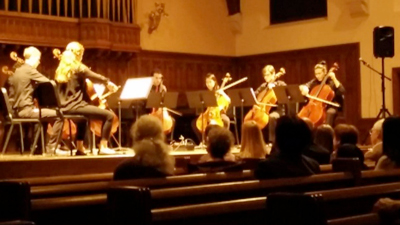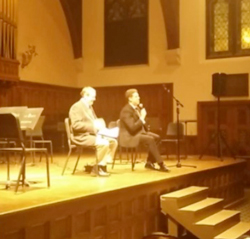by Carlyn Kessler

The cello has a soulful, lush quality that when multiplied to form a “cello choir” is uniquely striking and heart-rending. An ensemble of nine cellists, all CIM students of Richard Weiss, CCS president and first assistant principal cello of The Cleveland Orchestra, opened the program by unveiling this sound during the Grave and Fugue from G. F. Handel’s Concerto Grosso in d, Op. 3 No. 5. The fugal melodies enveloped the resonant chapel. The ensemble then turned to lighthearted music with Scott Joplin’s charmingly cheeky ragtimes, Chrysanthemum and The Easy Winners.
Five cellists from the Cleveland Orchestra Youth Orchestra, conducted by COYO Music Director and TCO Associate Conductor Brett Mitchell, performed Mozart’s motet Ave Verum Corpus. It was a natural choice: the cello is commonly viewed as being closely connected to the human voice in range and timbre. The young cellists matched each other’s sounds carefully. If your eyes were closed, you would not have known who was playing each part. Henry Shapard played the melody line with impressive beauty and sentiment.
The cello quartet Pizzicato Four (Heidi Albert, Nick Diodore, Ida Mercer, and Derek Snyder) began with a second motet, Olivier Messiaen’s O sacrum convivium, which shifted the mood of the program. All four cellists shined in what sounded like an eerie waltz. Mercer’s hauntingly beautiful melodic line was captivating. Afterwards, the quartet welcomed guest cellist Chauncey Aceret for Arvo Pärt’s Fratres (“brothers”). The work’s challenging solo part oscillates between sweeping, stormy arpeggiations and rich, chant-like lines in the upper register. Aceret embraced this challenge with easy showmanship. The quartet’s percussive pizzicato interruptions were prominent in the resonant hall.

“Are there any anecdotes that you’ve wanted to relate from the last 50 years, keeping in mind that we’re now in a chapel?” Mitchell asked. With a chuckle, Geber recalled meeting his soon-to-be dear friend Michael Tilson Thomas at their mutual BSO audition (they both won). He went on to tell a story about Yo-Yo Ma, who came to perform with TCO. Dohnányi had just moved the cello section to the inside.
“I was sitting right beside Yo-Yo Ma during the Shostakovich concerto,” said Geber. “During the very last pages of the work, he broke his A string. It’s impossible to go on at that point without having an A string because it’s all octaves and double stops, but he was trying to do it on the G and D strings. Anyway, with two minutes to go in the piece, he looked at me, and I looked at him. We had a bar of rest coming up, and ‘Woosh!’ we switched instruments!”
Geber also acknowledged his wife, former TCO principal harp Lisa Wellbaum, and fondly recalled touring with his children. Along with Richard Weiss’s son, they were “mascots of the orchestra, providing a refreshing air of humanity on the trips.”
Referring to Geber’s 42-year tenure at CIM, Mitchell asked if Geber has an overriding philosophy of teaching. “I like to work as if we’re a family,” Geber said. “One has to not only be careful with what one says, but also be sensitive and nurturing, and realize that no two individuals are the same. I like to approach teaching by working first on technical matters, as if you’re constructing a really beautiful building. You have to cement the foundation, then work on the music making.
Returning to the music, Mark Kosower, TCO principal cello, joined his CIM cello studio and soprano Natasha Ospina Simmons in two movements from Heitor Villa-Lobos’s Bachianas Brasileiras No. 5. Kosower said, “The piece deals with yearning and depicts Rio de Janeiro.” Kosower showed beautiful artistry in his solo in the “Aria.” With his expressive vibrato, he blended seamlessly with Simmons’s enchanting vocal line. In “Dansa,” the ensemble evoked a feisty flair and groove, transporting the audience to the colorful streets of Rio.
All of the cellists formed an impressive 32-piece orchestra for the last piece, Randall Thompson’s Alleluia. Conducted by Mitchell, the cello choir resounded with an all-encompassing warmth that filled the chapel, closing this memorable celebration of the cello.
Published on ClevelandClassical.com March 9, 2016.
Click here for a printable copy of this article


